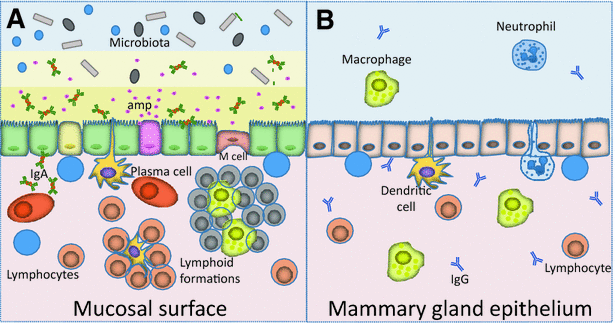Mammary microbiota of dairy ruminants: fact or fiction?
- PMID: 28412972
- PMCID: PMC5392980
- DOI: 10.1186/s13567-017-0429-2
Mammary microbiota of dairy ruminants: fact or fiction?
Abstract
Explorations of how the complex microbial communities that inhabit different body sites might contribute to health and disease have prompted research on the ways the harmonious relationship between a host and its microbiota could be used to keep animals healthy in their production conditions. In particular, there is a growing interest in the bacterial signatures that can be found in the milk of healthy or mastitic dairy cows. The concept of sterility of the healthy mammary gland of dairy ruminants has been challenged by the results of studies using bacterial DNA-based methodology. The newly obtained data have led to the concept of the intramammary microbiota composed of a complex community of diverse bacteria. Accordingly, mammary gland infections are not mere infections by a bacterial pathogen, but the consequence of mammary dysbiosis. This article develops the logical implications of this paradigm shift and shows how this concept is incompatible with current knowledge concerning the innate and adaptive immune system of the mammary gland of dairy ruminants. It also highlights how the concept of mammary microbiota clashes with results of experimental infections induced under controlled conditions or large field experiments that demonstrated the efficacy of the current mastitis control measures.
Figures

Similar articles
-
Invited review: Microbiota of the bovine udder: Contributing factors and potential implications for udder health and mastitis susceptibility.J Dairy Sci. 2018 Dec;101(12):10605-10625. doi: 10.3168/jds.2018-14860. Epub 2018 Oct 3. J Dairy Sci. 2018. PMID: 30292553 Review.
-
Mammary microbiome of lactating organic dairy cows varies by time, tissue site, and infection status.PLoS One. 2019 Nov 14;14(11):e0225001. doi: 10.1371/journal.pone.0225001. eCollection 2019. PLoS One. 2019. PMID: 31725757 Free PMC article.
-
Lactic Acid Bacteria Isolated from Bovine Mammary Microbiota: Potential Allies against Bovine Mastitis.PLoS One. 2015 Dec 29;10(12):e0144831. doi: 10.1371/journal.pone.0144831. eCollection 2015. PLoS One. 2015. PMID: 26713450 Free PMC article.
-
Understanding the Milk Microbiota.Vet Clin North Am Food Anim Pract. 2018 Nov;34(3):427-438. doi: 10.1016/j.cvfa.2018.06.003. Vet Clin North Am Food Anim Pract. 2018. PMID: 30316501 Review.
-
Normal milk microbiome is reestablished following experimental infection with Escherichia coli independent of intramammary antibiotic treatment with a third-generation cephalosporin in bovines.Microbiome. 2017 Jul 12;5(1):74. doi: 10.1186/s40168-017-0291-5. Microbiome. 2017. PMID: 28701174 Free PMC article. Clinical Trial.
Cited by
-
Milk microbiome diversity and bacterial group prevalence in a comparison between healthy Holstein Friesian and Rendena cows.PLoS One. 2018 Oct 24;13(10):e0205054. doi: 10.1371/journal.pone.0205054. eCollection 2018. PLoS One. 2018. PMID: 30356246 Free PMC article.
-
Exploring associations between the teat apex metagenome and Staphylococcus aureus intramammary infections in primiparous cows under organic directives.Appl Environ Microbiol. 2024 Apr 17;90(4):e0223423. doi: 10.1128/aem.02234-23. Epub 2024 Mar 18. Appl Environ Microbiol. 2024. PMID: 38497641 Free PMC article.
-
A Novel Lactobacilli-Based Teat Disinfectant for Improving Bacterial Communities in the Milks of Cow Teats with Subclinical Mastitis.Front Microbiol. 2017 Sep 26;8:1782. doi: 10.3389/fmicb.2017.01782. eCollection 2017. Front Microbiol. 2017. PMID: 29018412 Free PMC article.
-
Impact of intramammary inoculation of inactivated Lactobacillus rhamnosus and antibiotics on the milk microbiota of water buffalo with subclinical mastitis.PLoS One. 2019 Jan 7;14(1):e0210204. doi: 10.1371/journal.pone.0210204. eCollection 2019. PLoS One. 2019. PMID: 30615691 Free PMC article.
-
A core microbiota dominates a rich microbial diversity in the bovine udder and may indicate presence of dysbiosis.Sci Rep. 2020 Dec 10;10(1):21608. doi: 10.1038/s41598-020-77054-6. Sci Rep. 2020. PMID: 33303769 Free PMC article.
References
MeSH terms
LinkOut - more resources
Full Text Sources
Other Literature Sources

